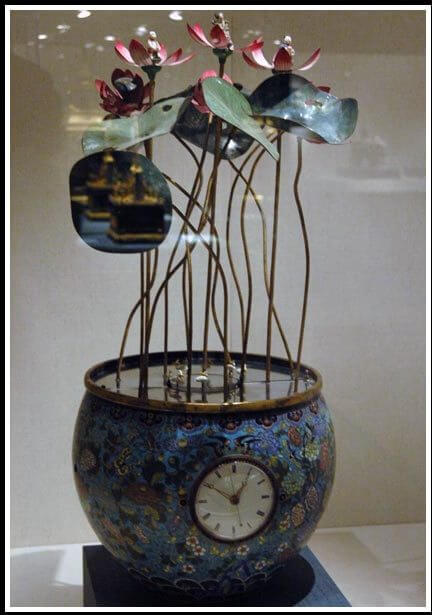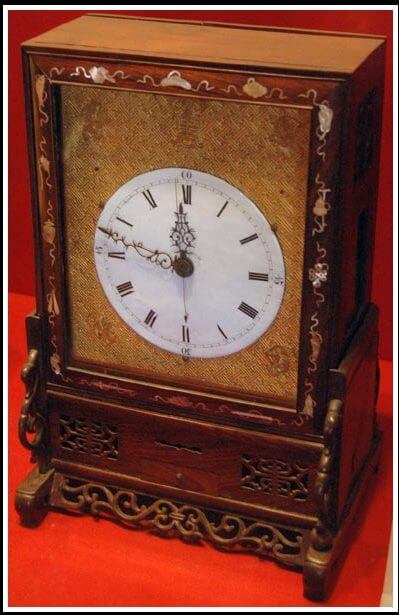The first Chinese clocks were reproductions of Western mechanical clocks, after which the transition from the Ming to the Qing Dynasty heralded a period of prosperity for Chinese clock-making. The Qing Palace Clock-Making Factory, Guangzhou and Jiangsu were three important centres of production.
Clocks made at the Qing Palace Clock-Making Factory
The Qing Palace Clock-Making Factory was set up in 1732 under the Yongzheng Emperor. It specialized in the production of chiming clocks and musical clocks. Numerous palace workshops, with expertise in enamelling, wood, gold, ivory or jade, were involved in production. Mainsprings and dials imported via Guangzhou guaranteed the clocks’ mechanical quality. A large clock could be several years in the making.
Musical clocks can play music at a specific time or, by operating a switch, on demand. The Blossoming Flower Clock (1) is one example of a clock made at the Qing Palace Clock-Making Factory using a musical mechanism from France. The clock’s dial is set inside a decorated brass pot, which holds a bouquet of blossoming lotus. When the clock is wound, three of the lotus buds open to reveal carvings of a white ape, a boy and the Queen of heaven.
Clocks made in Guangzhou
The term “Guangzhou clocks” refers to chiming clocks made in Guangzhou from the Qing Dynasty to the Republic of China. The quality of Guangzhou clocks in the late 18th century equalled that of English clocks at two-thirds the price… although this was still more than the ordinary citizen could afford. Most of the clocks made by the Guangzhou workshop were for honorary gifts or for senior officials and rich merchants, which significantly limited its development.
Guangzhou clocks have extremely rich national and regional characteristics. Some were modelled to resemble buildings such as houses, kiosks, theatres or pagodas. Others were given the form of a gourd, precious vase or flowerpot. Their cases were resplendent in gilded copper, sometimes painted over with characteristically bright Guangzhou enamel in transparent yellow, green, blue, etc. Artisans in Guangzhou invented a form of craftsmanship that combined Western enamelling techniques with Chinese characteristics. Formal decoration took peaceful and grand occasions as its subject and was intended to convey propitious meanings. Each clock did more than simply give the time: it came to life. The gourd-shaped clock (2) contains a musical box in the first level, with banners and a crowd of figures presenting treasures. When the music begins to play, the banner is unfurled to spell out “forever happy” in Chinese characters and the figures move.
Clocks made in the Jiangsu province
The development, during the Qing Dynasty, of agriculture and handicrafts in Kangxi, Yongzheng and Qianlong not only brought commercial prosperity; it also laid the foundations for a clock industry, located downstream of Yangtze River. In his 1809 treatise The Illustrated Explanation of Chiming Clocks in Songjiang (now Shanghai), Xu Chaojun narrated in great detail the clock’s structure, function, maintenance and repair. His book was the first in Chinese history to be entirely devoted to mechanical clock-making. In 1816, the clock-making guild built an inscription at a memorial park, five miles from Suzhou. It testifies to the long history of clock-making in Suzhou.
Clocks made in Jiangsu are generally known as Su clocks. At the end of the Qing Dynasty, Su clocks looked to traditional Eastern culture for their design, which added to their elegant simplicity and enhanced their ornamental value. Jiangsu earned a fine reputation for screen clocks whose internal parts were completely handmade, in particular the lifelike engravings on gilded copper sheets. They demonstrate the skilled craftsman’s intelligence and wisdom, and a complete mastery of technique. The clocks can be divided into three parts: the foundation, the screen and the case. Most are carved from red wood (3) although some incorporate mother-of-pearl to enhance their value. Others are inspired by Ming furniture or use skeleton engraving, depending on the period.













